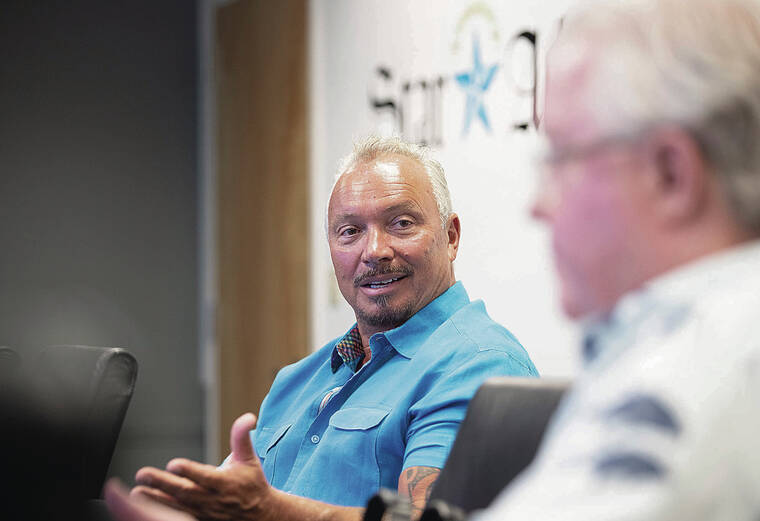End-of-summer vacationers, mostly from the U.S., nearly filled Hawaii hotel rooms to pre-pandemic levels in August and drove the average daily room rate to almost $383 per night.
Hotel occupancy statewide in August was at 77.1%, down 7 percentage points from August 2019, according to the Hawaii Hotel Performance Report published by the Hawaii Tourism Authority, using data from STR, a global hospitality data and analytics company.
Travelers also were willing to pay much higher rates for hotel rooms across the state in August, when the average daily rate was more than 32% higher than the August 2019 level.
The dramatic rise in the average daily room rate, or ADR, helped revenue per available room, or RevPAR, increase to more than $295, up 21% from August 2019. RevPAR is considered by many in the hotel industry as the key performance measure as it is the rate that a room rents for regardless of occupancy status.
Still, August hotel performance results were mixed across the islands, and hoteliers say some signs of slowing have emerged, with bookings decelerating for the fall and keeping the festive season in December and January from already being sold out.
Keith Vieira, principal of KV &Associates, Hospitality Consulting, said, “Advance bookings for fall started to slow in midsummer. The economy is a concern. Inflation is a concern.”
Vieira said Hawaii’s festive season, which runs from Dec. 23 to Jan. 3, tends to be a good indicator of the market’s strength.
He said it’s a bit concerning that at this point “most hotels for the festive season are not where we expected them to be. We need to be aggressively marketing Hawaii.”
Jerry Gibson, president of the Hawaii Hotel Alliance, said he doesn’t know whether the festive season “will be full like in 2019.” However, he said some hoteliers expect to get there, while the larger hotels still have opportunities for growth.
Ultimately, Gibson said he expects festive season to come in stronger than August, although the period from July 1 to Aug. 15 is historically the busiest time for many Hawaii hotels.
Gibson said that in August many hoteliers were still struggling from a lack of group and association business, which has lagged since the pandemic.
“The group portion on the neighbor islands can be 30% to 40%, and there hasn’t been enough time to build it up so soon after the pandemic,” he said. “The lack of group business comes as demand is just not as robust as it once was. The kids are back in school. We still don’t have all of the international visitors back.”
Hotel performance varied across the counties in August. All saw double-
digit revenue climbs in August, save for Oahu, whose single-digit revenue climb reflected in part a lack of higher-spending international travelers, who have yet to return to 2019 levels. Statewide hotel revenue in August reached more than $509 million, a gain of almost 25% from the more than $408 million attained in August 2019.
Oahu hotels reported an occupancy of 81.6%, down 7.3 percentage points from 2019. Oahu’s ADR was more than $286, an increase of more than 12% from August 2019, and its RevPAR was almost $234, a rise of 3% during the same period. Hotel revenue on Oahu in August rose above $222 million, an almost 25% increase from August 2019.
Maui had the highest ADR and RevPAR but the greatest occupancy drop from August 2019. Maui County hotels led the counties in August in terms of ADR, which at $621 was up almost 58% from August 2019. RevPAR nearly reached $422, an increase of 38% from August 2019. However, Maui’s occupancy at 67.9% was 10 percentage points below August 2019. Maui County hotel revenue in August rose to nearly $175 million, a gain of nearly 46% from August 2019.
Hawaii island hotels reached an occupancy of 73.4% in August, which was 7.5 percentage points below the same month in 2019. Hawaii island’s ADR was almost $409, an increase of about 46% from August 2019, and its RevPAR, at more than $300, was up more than 32% above August 2019. Hotel revenue in August on Hawaii island was greater than $65 million, up almost 44% from August 2019.
August occupancy at Kauai hotels reached 79.2%, up 5.5 percentage points from August 2019. Kauai’s April ADR was more than $415, up more than 46% from the same month in 2019, and its RevPAR was more than $329, an increase of more than 57% from August 2019. Hotel revenue on Kauai in August was $47 million, up more than 59% from August 2019.
In contrast, the state Department of Business, Economic Development and Tourism reported in its Hawaii Vacation Rental Performance Report that Hawaii’s vacation rentals had higher ADR in August than during the same month in 2019, but vacation rental supply, demand and occupancy were lower.
DBEDT’s vacation rental definition includes the use of a rental house, condominium unit, private room in a private home or shared room/space in a private home. DBEDT’s vacation rental report excludes units included in its hotel and timeshare reports.
In August the total monthly supply of statewide vacation rentals was 674,000 unit nights, down 26.5% from August 2019. Monthly demand in August was 435,800 unit nights, which was more than 36% lower than August 2019.
As a result, the average monthly unit occupancy for vacation rentals in August was 64.7%, down
9.6 percentage points from August 2019. The ADR for vacation rental units statewide in August was $300, up nearly 47% from August 2019.

